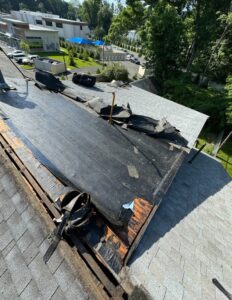
A roof is one of the most important aspects of a home. Not only does it keep the elements out, but it also protects the structure of the house. A roof that isn’t properly ventilated can lead to a number of problems, including roofing damage and even structural damage. In this blog post, we will discuss why roof ventilation is so important and how you can go about ensuring that your home has proper ventilation.
How Attic Ventilation Works
The attic is one of the most important areas of a home when it comes to roof ventilation. The attic is where the roofing system and insulation are located, so it’s important to ensure that it is properly ventilated. Attic ventilation works by drawing in cool air from outside and expelling hot air from inside the attic. This helps to keep the attic cool and prevents the roofing system and insulation from overheating.
If the attic isn’t properly ventilated, it can lead to a number of problems, including roofing damage, insulation failure, and even structural damage. In order to ensure that your home has proper ventilation, you need to have both roof vents and gable vents.
roof vents are located on the roof and are used to draw in cool air from outside. Gable vents are located on the gables of the house and are used to expel hot air from inside the attic. If you don’t have both roof vents and gable vents, your home will not have proper ventilation.
How to Install Roof Vents
If you need to install roof vents, you can do it yourself or hire a professional roofing contractor. If you choose to do it yourself, here are the steps you need to take:
- Locate the roof vents. The roof vents should be installed in an area that is shaded by the sun.
- Mark the location of the roof vents.
- Drill a hole in the roof for each roof vent. Make sure that the holes are big enough to fit the roof vents.
- Insert the roof vents into the holes and secure them with screws.
- Seal any seams between the roof and roof vents with roofing cement.
How to Install Gable Vents
If you need to install gable vents, you can do it yourself or hire a professional roofing contractor. If you choose to do it yourself, here are the steps you need to take:
- Locate the gable vents. The gable vents should be installed in an area that is shaded by the sun.
- Mark the location of the gable vents.
- Drill a hole in the roof for each gable vent. Make sure that the holes are big enough to fit the gable vents.
- Insert the gable vents into the holes and secure them with screws.
- Seal any seams between the roof and gable vents with roofing cement.
If you need to install roof vents or gable vents, please contact a professional roofing contractor for assistance. A professional roofing contractor will be able to properly install roof vents and gable vents in your home, ensuring that your home has proper roof ventilation.
What is roof ventilation and why is it important for your home?
Roof ventilation is the process of removing hot air and moisture from the roofing system. This is important because it helps to protect the roofing materials from damage and allows for proper airflow through the roof. Roof ventilation also helps to improve the energy efficiency of your home, as it allows for cooler air to enter your home in the summertime.
If you are looking for a roofing contractor in your area, be sure to contact us. We would be happy to help you with all your roofing needs!
Thank you for reading our blog post! We hope that you have found it helpful. Be sure to check back soon for more roofing tips and information.
The different types of roof ventilation systems
There are a number of different roof ventilation systems that you can choose from, depending on your needs and budget. The most common types of roof ventilation systems include:
- Roof vents
- Gable vents
- Ridge vents
- Roof turbines
Each of these roof ventilation systems has its own advantages and disadvantages, so be sure to research them all before making a decision.
If you are in need of a roofing contractor, please contact us today. We would be happy to help you choose the right roof ventilation system for your home!
Why Adequate Roof Ventilation is Important
Ventilation in your attic is one of the most important factors to consider when it comes to preventing damage from excessive heat and moisture. The excess energy that’s built up due to this problem can lead not only dofamernan issues but also cost you more money!
When the heat is turned up in your attic, it can warp roof sheathing and make shingles age quicker. If there isn’t an adequately insulating floor below that source of extra energy consumption for cooling purposes then you’ll be paying more on electricity bills to keep a comfortable living environment inside!
When the temperature drops below freezing during winter, warm air escaping into an attic from inside your house will rise up through it and cause water to trickle down on top of any snow that’s there.
The runoff from your roof can lead to ice damming up along the eaves, causing water damage inside. This is where a properly installed self-adhered underlayment comes into play! It seals tight around nails and prevents any overflow from entering exterior walls or attic spaces where it could saturate floor insulation ruining drywall underneath as well as interior room dividers if there are no gutters attached.
Humidity in the air is terrible for your home. It not only causes mold and mildew growth but also damages insulation causing more expensive repair work on cooling systems which could lead to pantry collapsing or other structural issues!
In order to avoid these problems make sure there’s minimal humidity coming from any source inside (or outside) by using fans when possible; wipe down surfaces with tissues every day after use – especially near doors where moisture tends to settle faster than elsewhere around the house.
Benefits of Ventilation
The insulated attic space is a great place to store your home’s heat and electricity. The air flowing through it during any temperature provides a balance between what’s inside versus outside, making HVAC systems less busy with work that can be done at night or on weekends when they’re not needed for ventilation purposes only!
The roof system of your home protects you from rain, sun, and hail. A lack of ventilation can lead to problems with molding that may even make its way into the HVAC unit below it! This will result in expensive repairs down the line such as wood rot attic beams or supports for ceilings above rooms where this type of fungus thrive most heavily – like bedrooms.
The right ventilation system also ensures that you’re getting enough oxygen and prevents the buildup of carbon monoxide. Although your HVAC has a fan to circulate air through your home, it’s still recommended for safety reasons to install CO2 detectors in all rooms where there is natural light exposure or constant human activity like sleeping areas because they can sense when someone might be sicker than others (even without Openingtheir windows).
How to install a roof ventilation system
There are many roof ventilation systems on the market, so it’s important to do your homework research on them all before making a decision.
If you are in need of a roofing contractor, please contact us today. We would be happy to help you choose the right roof ventilation system for your home!
How to determine if you need roof ventilation
The best way to determine if you need roof ventilation is to inspect your roof for signs of moisture damage. If you see any mold or mildew, then it’s likely that you need roof ventilation.
Another way to determine if you need roof ventilation is to check your energy bills. If you’re paying more than usual for cooling or heating, then it’s likely that you need roof ventilation.
Finally, you can also use a carbon monoxide detector to determine if you need roof ventilation. If the detector is picking up high levels of carbon monoxide, then it’s likely that you need roof ventilation.
If you’re in need of a roofing contractor, please contact us today. We would be happy to help you choose the right roof ventilation system for your home!
Conclusion:
It’s important to have proper roof ventilation in order to keep your home healthy and comfortable. Not only will you save on energy costs, but you’ll also avoid moisture damage that can lead to costly repairs down the road. If you’re not sure whether your home needs a new roof ventilation system, give us a call. We can inspect your roof and recommend the best solution for your needs. Thanks for reading!




